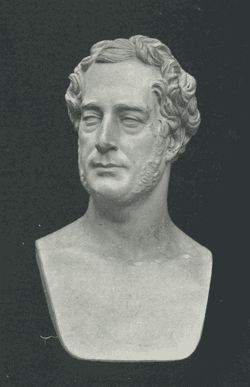John Doyle, Caricaturist
(b. 1797, d. 1868)
Caricaturist
From A Dictionary of Irish Artists 1913

John Doyle. Plaster Bust, by Christopher Moore; in National Gallery of Ireland.
Was born in Dublin in 1797. His father, who was in business, belonged to a family which had come from the King's, or Queen's, County. At an early age he entered the drawing school of the Dublin Society, where he won a medal in 1805, and later he was a pupil of Gaspare Gabrielli (q.v.), and of John Comerford the miniature painter. Starting as an artist he painted a few portraits, but made his reputation as a painter of horses, a branch of art in which he excelled. He received much help in his early efforts to gain a footing as an artist from Judge Mayne, and received th patronage of the Lord Lieutenant, Earl Talbot, and the Marquess of Sligo.
At the age of 17 in 1814, he exhibited three portraits of horses with the Hibernian Society of Artists, and he was also represented in the exhibitions in the Dublin Society's House in Hawkins Street in 1815, 1817, and in 1819, and in the Royal Arcade in 1821, exhibiting in all nineteen portraits of horses. About the end of 1821 he went to London and struggled for a time to obtain a footing as a portrait painter in oil and miniature, exhibiting occasionally in the Royal Academy from 1825 to 1835. In 1822 he published six plates of "The Life of a Racehorse," and in 1827 found his true role as a political caricaturist.
Showing some drawings to McLean the print-seller, he was prevailed on to publish them. Their success was so marked that it was decided to continue them, and thus was begun the series of lithographs known as the HB caricatures which continued for a period of upwards of twenty-two years. From the first the identity of the artist was concealed; the signature HB was formed of two I.D.'s, one above the other—ID/ID. The caricatures came out at irregular intervals, three or four at a time, beginning in 1829 and ending in 1851. The subjects related to the political events and the political men of the time treated without the exaggeration and coarseness of the caricatures of Gillray, and drawn with a humour never descending to vulgarity. The likenesses were faithfully preserved—they were indeed hardly caricatures at all, but characteristic portraits of all who figured prominently in political life and public events.
In his drawing of figures Doyle was far below Gillray or Rowlandson or Cruikshank, but he improved as he went on, and his horses were always drawn with knowledge. Hayden said that HB "had an instinct for expression and a power of drawing without academic cant I never saw before"; and Austin Dobson writes ("Dictionary of National Biography"): "It is certain that during their epoch Doyle's designs led English satiric art into a path of reticence and good breeding which it had never trodden before; and for English graphic political history between 1830 and 1845 one must go chiefly to the drawings of HB." The series continued until 1851, the total number of lithographs being 917. The greater part of them, beginning with the first number, 13th November, 1829, and ending at No. 825, 28th December, 1844, were published in fifteen volumes, oblong folio. Doyle also did "Equestrian Sketches" published by McLean, and made the drawing for the large engraving of "The Reform Bill receiving the King's assent by Royal Commission," 1836.
After the cessation of the HB caricatures Doyle lived a quiet and retired life for seventeen years before his death, which took place on 2nd January, 1868.
Six hundred and ten of the original drawings in pen and pencil, and a few in chalk for the HB series, are in the British Museum. A portrait in oils of Christopher Moore, sculptor, is in the National Gallery of Ireland.
Doyle, by his wife Marianne, daughter of James Conan of Dublin, was father of four sons who inherited his artistic talents—James William Edmund, Richard, Henry Edward and Charles, who are separately noticed.
« James William Edmund Doyle | Contents and Search | Richard Doyle »
